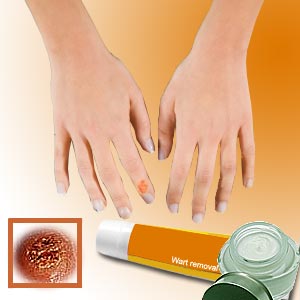Wart Removal

A wart is a skin tumor caused by caused by the human papilloma wart virus (HPV virus). Warts are benign tumors that appear as small, circumscribed tumors of the outer layer of the skin. They can be either flat or elevated and can occur anywhere on the human body.
Hands and fingers are pretty common sites, but they can appear on the face and genital areas also Warts are often painful, unsightly and embarrassing. This article examines various methods of wart removal.
Treatment of Warts
Treating warts reduces the chances of spreading to other areas of the body and to other people. But it has to be kept in mind that wart removal in any location may be difficult and there are fair chances of them re-appearing following any treatment.
There are hosts of ways to treat warts ranging from over the counter medicines to surgery. One major point to be remembered is that treatment of warts on normal skin areas like hands and feet are entirely different from treatment of warts in the genital areas. It is definitely advisable to treat the genital warts by a registered doctor.
Topical applications: One of the common methods of treating warts is to apply topical ointment/creams and sprays which are easily available. The biggest advantage of these creams and sprays is that patients can use them in the privacy of their homes. These topical creams contain certain chemicals and acids which attack the human papilloma virus, the cause of warts.
Blistering agents: Another method of treating warts is by using blistering agents such as podophyllin or burning off the warts using potent acids like bichloroacetic acid or trichloroacetic acid. But these chemicals can irritate and burn if they accidentally happen to touch the normal skin. Hence it would be a good idea to take the help of a trained doctor while applying these chemicals.
Another common method for removal of warts is to apply the chemical cantharidin on the affected area. It is covered by a bandage. After a few hours, the patient may experience pain and blistering of the wart. The bandage is removed after 24hrs. The dead skin will be removed later.
Salicylic Acid: Warts can also be treated by applying salicylic acid. It has to be applied everyday for many weeks to produce results. Applying the acid on damp skin is advisable as it helps the acid to penetrate deeply. A pumice stone can be used to file away the dead surface of the warts.
Duct tape: Duct tape is also widely used in the removal of warts. Warts can be covered with duct tape for up to a week. This produces irritation to the wart and the skin around it causing the body to attack it. After a week, the tape can be removed. Soak the wart in water and rub it with a pumice stone or an emery board.
Cryotherapy: Another treatment called cryotherapy uses liquid nitrogen to freeze the wart. It does cause some discomfort and the treatment may last up to 3-4 weeks. This method of wart removal has a fairly high success rate and reduces chances of scarring.
Laser removal of warts: Warts can also be removed by laser surgery where a stream of laser light is directed at the infected site. But this treatment can be painful and may also leave a scar.
Cauterization: Electro-cauterization is a method where in a heated electric needle is applied to the growth, thereby destroying the wart. This treatment is also very painful and can leave a scar.
Surgery: The doctor may also treat the wart by surgical excision. Here, the area is injected with Lidocaine to numb it and then the wart is removed by cutting out the infected area. Not only is it painful but it may leave a scar also.
Removal of genital warts
Treatment of warts in the genitals requires more care and caution. Removal of genital warts needs medical supervision. Warts may be treated with podophyllin, or may be frozen with liquid nitrogen. A method called Loop electrosurgical excision procedure (LEEP) wherein a sharp instrument shaped like a loop is passed under the wart, cutting it out of the skin.
Alternatively, laser surgery is also used. A chemical called Interferon is also injected into the warts. This chemical helps the body's immune system fight the virus but this treatment is pretty expensive and the effectiveness of this method is only 50%.
Home remedies for removal of warts
Sometimes, it may so happen that the best of the medicines don't work while some simple home remedies are effective. Given below are a few simple solutions:
- Apply vitamin E oil to the surrounding areas and then place a clove of crushed raw garlic on the wart and cover it with an adhesive tape. A blister is formed and the wart usually falls off within a week.
- Cover onion slices with salt and leave overnight. Apply the resulting juice to the affected area till the warts disappear.
- Apply the milky juice from the stems of figs and leaves. Alternatively, the juice of cauliflower, lime, onion and green papaya are also effective. Apply them 2-3 times a day.
- Castor oil can also be applied. Rubbing a piece of fresh pineapple or raw potato or radish peels will also help.
- Soak a cotton ball in apple cider vinegar and stick it on to the wart with a band aid. Leave on for 15 minutes, wash off and dry.
- Make a thick of aspirin and water, apply on the wart and cover it. Do it 2-3 times a day. Mix baking soda in water and rub on wart 2-3 times a day.
Whatever the form of treatment be, it is very necessary to stay the course. Do not give up as home remedies may take weeks, even months to show results.
Preventing warts
Warts are contagious and can easily spread from one areas of the body to another through scratching, picking at it or any form of skin contact. They can also spread from person to person if there are any cuts and scrapes in the skin. Genital warts may be passed on through close physical contact. So it is better to prevent the infection by following a few simple guidelines regarding personal hygiene.
It is always better to wear footwear in the shower/locker room of the gym/pool. Persons with wart should not share their towel, pillows, bed, shoes, etc. The bathrooms must be thoroughly disinfected after use by an infected person. Treat all the warts in the given area so that they do not spread. Shaving will also spread the virus, hence it is better to stop shaving till the area is cleared of warts.
Top of the Page: Wart Removal
Tags:#wart removal
 Beauty
Beauty Cosmetic Surgery
Face
Cheek Implants
Mini Facelift
Non Surgical Face Lift
Eyebrow Transplantation
Cosmetic Eye Surgery
Ear Plastic Surgery
Rhinoplasty
Chin Liposuction
Cosmetic Dentistry
Facial Cosmetic Surgery
Chin Surgery
Reconstructive Facial Surgery
Body
Sublative Rejuvenation
Lower Body Lift
Anti-ageing Cosmetics
Wart Removal
Mole Removal
Breast Augmentation
Liposuction
Liposuction Surgery
Cosmetic Laser Surgery
Spider Vein Laser Surgery
Abdominal Liposuction
Umbilicoplasty Surgery
Plasma Skin Resurfacing
Skin Tag Removal
Top of the Page: Wart Removal
Popularity Index: 101,237

